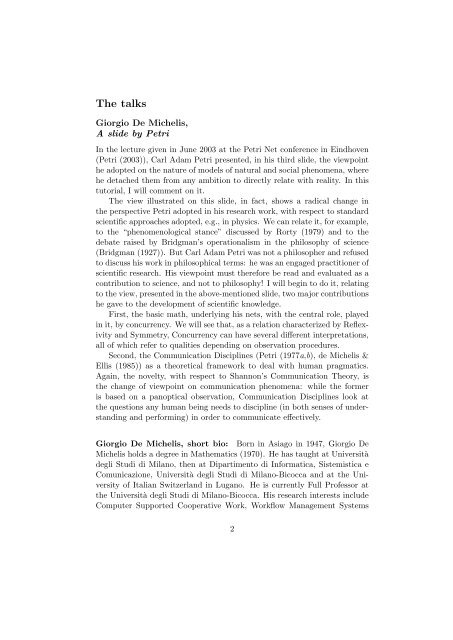Nets, Physics and Coordination - Models of Concurrency ...
Nets, Physics and Coordination - Models of Concurrency ...
Nets, Physics and Coordination - Models of Concurrency ...
You also want an ePaper? Increase the reach of your titles
YUMPU automatically turns print PDFs into web optimized ePapers that Google loves.
The talksGiorgio De Michelis,A slide by PetriIn the lecture given in June 2003 at the Petri Net conference in Eindhoven(Petri (2003)), Carl Adam Petri presented, in his third slide, the viewpointhe adopted on the nature <strong>of</strong> models <strong>of</strong> natural <strong>and</strong> social phenomena, wherehe detached them from any ambition to directly relate with reality. In thistutorial, I will comment on it.The view illustrated on this slide, in fact, shows a radical change inthe perspective Petri adopted in his research work, with respect to st<strong>and</strong>ardscientific approaches adopted, e.g., in physics. We can relate it, for example,to the “phenomenological stance” discussed by Rorty (1979) <strong>and</strong> to thedebate raised by Bridgman’s operationalism in the philosophy <strong>of</strong> science(Bridgman (1927)). But Carl Adam Petri was not a philosopher <strong>and</strong> refusedto discuss his work in philosophical terms: he was an engaged practitioner <strong>of</strong>scientific research. His viewpoint must therefore be read <strong>and</strong> evaluated as acontribution to science, <strong>and</strong> not to philosophy! I will begin to do it, relatingto the view, presented in the above-mentioned slide, two major contributionshe gave to the development <strong>of</strong> scientific knowledge.First, the basic math, underlying his nets, with the central role, playedin it, by concurrency. We will see that, as a relation characterized by Reflexivity<strong>and</strong> Symmetry, <strong>Concurrency</strong> can have several different interpretations,all <strong>of</strong> which refer to qualities depending on observation procedures.Second, the Communication Disciplines (Petri (1977a,b), de Michelis &Ellis (1985)) as a theoretical framework to deal with human pragmatics.Again, the novelty, with respect to Shannon’s Communication Theory, isthe change <strong>of</strong> viewpoint on communication phenomena: while the formeris based on a panoptical observation, Communication Disciplines look atthe questions any human being needs to discipline (in both senses <strong>of</strong> underst<strong>and</strong>ing<strong>and</strong> performing) in order to communicate effectively.Giorgio De Michelis, short bio: Born in Asiago in 1947, Giorgio DeMichelis holds a degree in Mathematics (1970). He has taught at Universitàdegli Studi di Milano, then at Dipartimento di Informatica, Sistemistica eComunicazione, Università degli Studi di Milano-Bicocca <strong>and</strong> at the University<strong>of</strong> Italian Switzerl<strong>and</strong> in Lugano. He is currently Full Pr<strong>of</strong>essor atthe Università degli Studi di Milano-Bicocca. His research interests includeComputer Supported Cooperative Work, Workflow Management Systems2
















